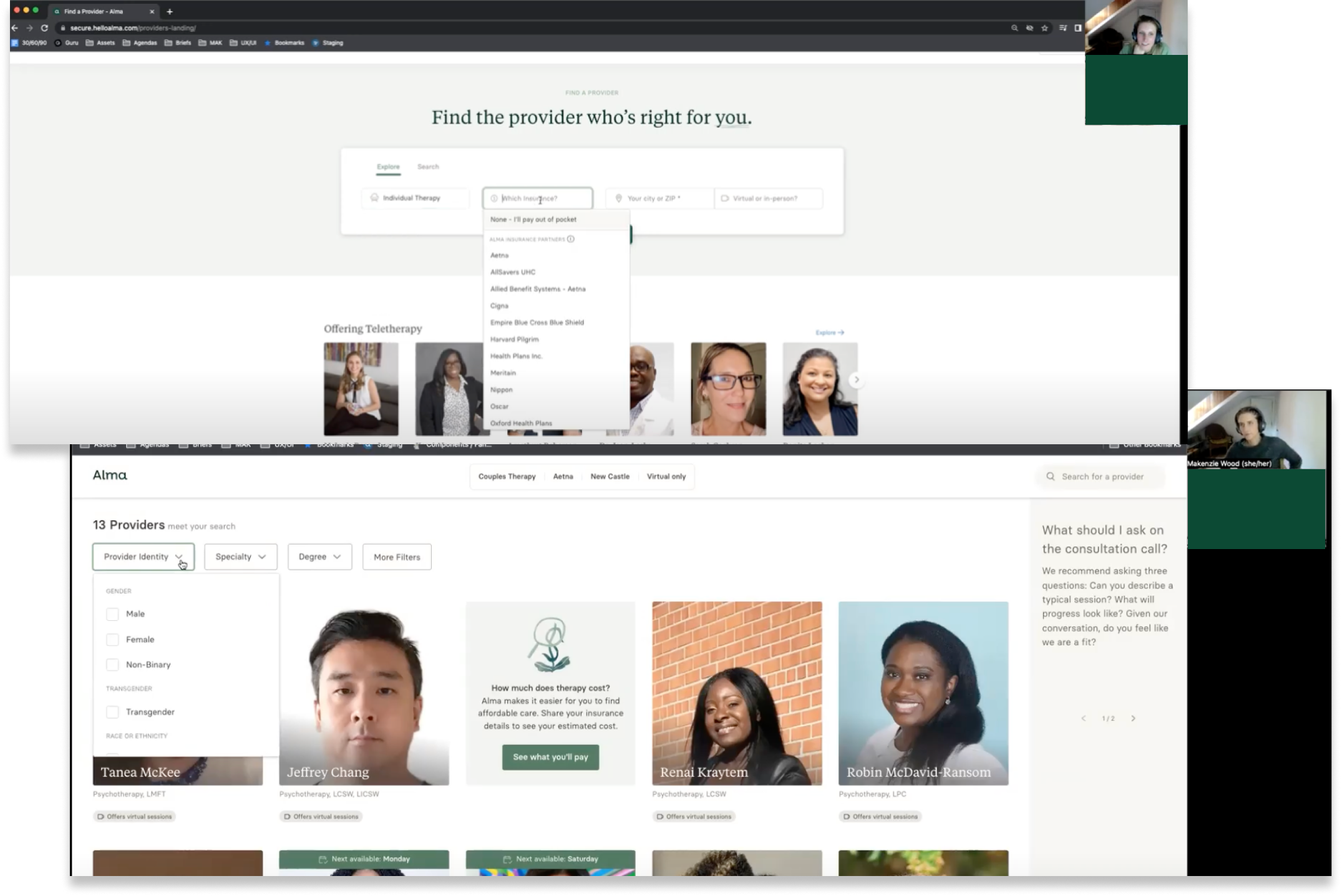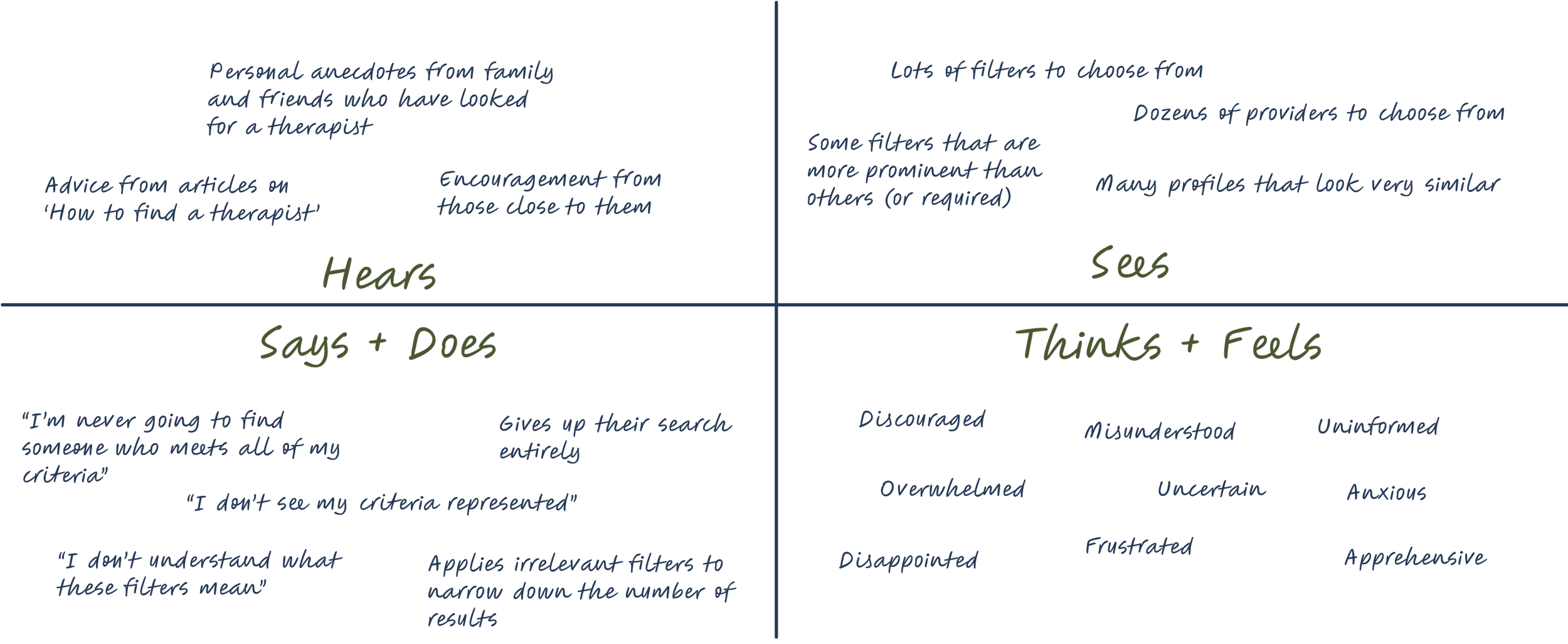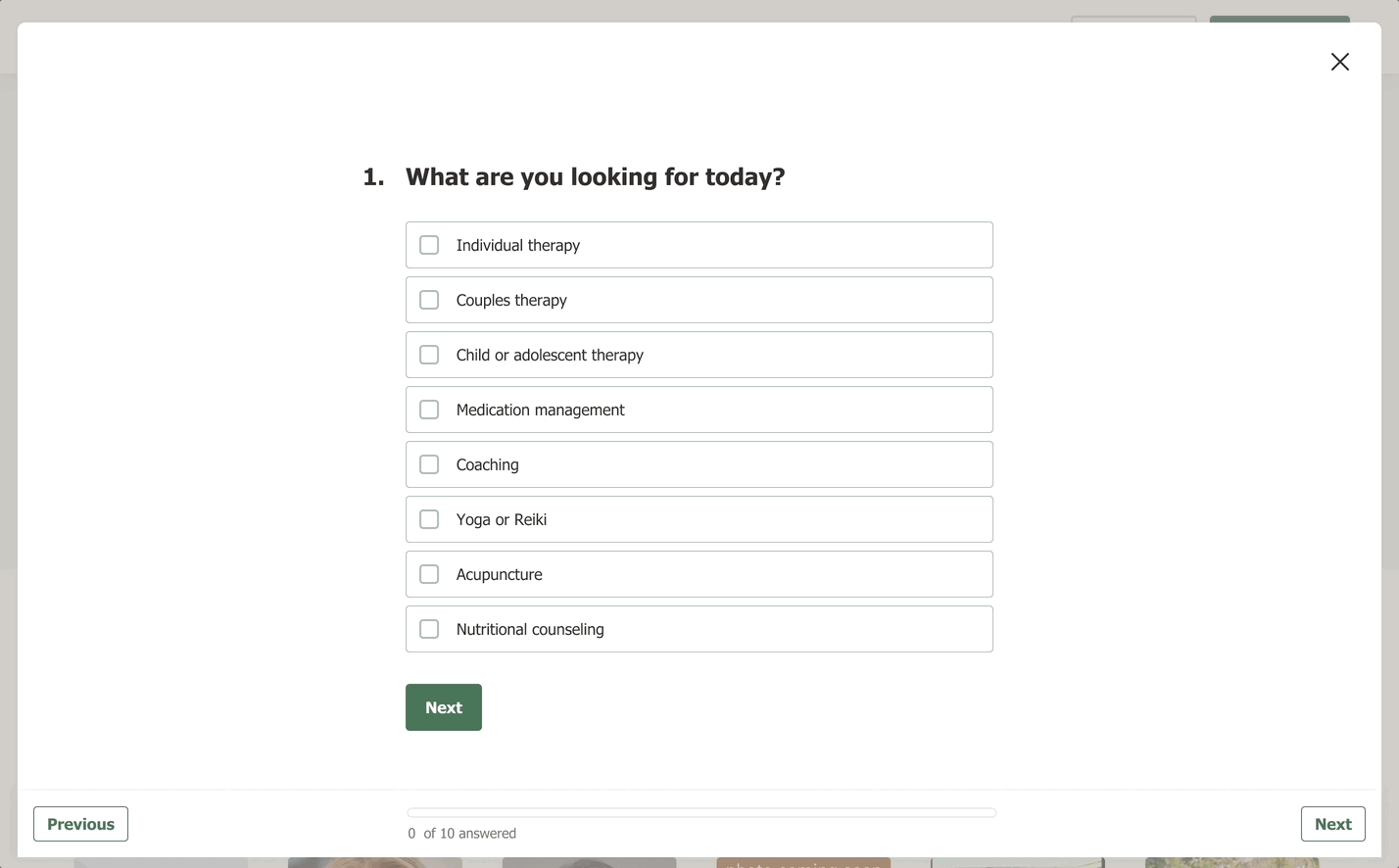Humanizing the search for a therapist
Designing an alternative to traditional filter and search directories
Timeline: December ‘22 - March ‘23
Role: Lead researcher and co-designer
Background: Alma is a platform that supports mental health providers in running their private practice. As part of its service, Alma also helps individuals seeking care connect with a therapist in Alma’s community.
CONTEXT
60% of clients ultimately abandoned their search before choosing a therapist.
Alma offers a 1:1 personalized matching service for clients seeking care. That service’s conversion rate was 100% higher than that of traditional search. What made the ‘matching’ service so effective was that it connected clients to a real person. Users could share their preferences with someone who could translate that information into filters and criteria in our search directory.
The problem? That service couldn’t scale.
How might we replicate a highly personalized experience that is able to scale?
HYPOTHESIS
Individuals abandon their search for a therapist because they are unsure of what to look for and how to narrow their options down.
They know they want to start therapy, but lack confidence in their ability to articulate what they are looking for and evaluate a provider against that criteria. Prospective clients are not always familiar with mental healthcare terminology and the factors that can influence finding and choosing a provider who meets their needs. Even those that are familiar can still struggle to articulate their search criteria and apply it.
GOALS
Design a feature that felt engaging and personalized that scales.
To do this we needed to better understand the experience of clients who felt confident searching for a therapist on their own.
How do they determine which criteria matter most to them?
What indicators did they use to choose a provider?
Are there universal criteria that seem to matter most?
RESEARCH
User interviews
Through user interviews I discovered that there is very little method or strategy behind the majority of searches happening on Alma’s directory. Clients wanted to get their results as soon as possible and cared a lot about being able to afford their care (no surprises there). But the most critical insight we uncovered was that when clients lack confidence in applying filters or defining their criteria, they simply didn’t apply them. Even if that criteria is critical to their ability to find the right therapist.
I conducted individual, 45-minute interviews with 7 clients, some of whom had used Alma’s services in the past. I observed them navigating our current search experience and gained insight into how they applied filters as they conducted a mock search for a therapist on Alma’s directory.
“When I’m a patient I don’t know these terms, but I know how I want to feel…”
“Even though I have a specific style in mind that I want my therapist to have, I’m not sure where it falls [within the filters].”
“This [filter] feels important but I’m wondering if I should even choose one because it might really limit my results.”
How do we instill confidence in clients while they search for a therapist?
We knew we wanted to design some type of experience that collected information from clients in a gradual and responsive way. I looked at other products in the healthcare space to understand how clients might experience seeking other types of care or therapy via other products.
It was important for the experience to reduce feelings of overwhelm by feeling familiar.
Empathy mapping
I made empathy maps to further identify what might be driving lack of confidence
Competitive Analysis
IDEATION
Experience audit
We focused our efforts on designing an experience that emphasized flexibility and transparency. Though we couldn’t tailor the experience to each client’s unique preferences, we could educate them during the process, in turn improve their perceived self-efficacy and bolster their confidence so that they search for what really matters most to them.
We took stock of the current experience by asking questions like:
Which filters do we currently support?
Are we missing important filters?
What are all of the possible filter combinations?
Where will education have the most value?
Early sketches
Early low-fi
User journey mapping
DESIGN
Iteration
As we continued to iterate, some key insights emerged that helped to focus our efforts
The new search experience will take 2x longer than the current experience. How do we build trust right away to maintain motivation?
Lead with a more approachable, grounding question
Tell users up front how many questions to expect
Hide the count of remaining providers - this is anxiety-provoking
The results page is a critical point in the user journey. How can we maximize the value of this stage while keeping the UI simple to prevent overwhelming the user?
Motivate users to view near-matches before adjusting their criteria
Provide more context about what to expect next
Add humanity with pictures of real providers
Testing
We released the new feature to 25% of clients who came to Alma seeking a therapist and found that those who used the new feature had a 10% higher likelihood of finding a provider than those who used the traditional directory search.
Clients might feel forced to apply every filter, even if they don’t have a preference. How can we provide suggestions without being too prescriptive?
Add accessible educational content
Give users the option of not having a preference
Deliverable highlights
Educate, don’t overburden
Sometimes the preference is no preference
SOLUTION
Alma’s new search experience
Put the user in control of when and how they compromise
IMPACT
Only 30% of clients who applied search criteria on Alma’s homepage ended up viewing their search results.
For clients who used the new feature, that number was 75%
About 18% of clients who use the traditional search experience and apply filters independently end up choosing a therapist and sending them a message.
For clients who use the feature, that number is 28%
LESSONS LEARNED
More testing
Conducting a resonance test would have allowed us to answer the question of whether or not we had the right solution in mind.
Does a quiz format meet user needs and expectations?
Additionally, usability testing before we shipped could have confirmed we had the right execution in mind.
Does the experience actually instill more confidence in users?
Leveraging the insights we gained during user testing could have allowed us to develop user personas, which would have provided invaluable insight into whether we were asking for the right criteria throughout the experience.







